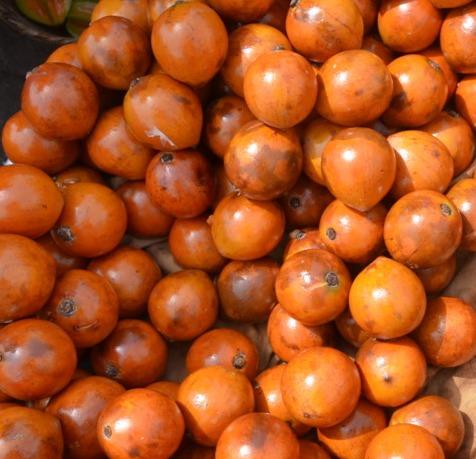Gongronema latifolium belongs to the family of plants known as Asclepiadaceae. It is widespread in the tropical rainforest of West African countries, such as Nigeria, Côte d’Ivoire, Sierra Leone, Ghana and Senegal. It is called utazi by the Ibos, arokeke by the Yorubas and urasi by the Efiks and the Ibibios.
This class of medicinal plants is beneficial in preventing and treating certain diseases and ailments that are detrimental to human health. The leaves, which can be chewed, infused or used for cooking, are mainly used in the Western part of Africa for nutritional and medicinal reasons.

Characteristics and constituents
Utazi has a characteristic sharp, bitter and slightly sweet taste, especially when eaten fresh. It contains essential oils, glycoside, alkaloids, saponins and tannin, various minerals, vitamins and some essential amino acids. The leaves have very high nutritional value and contain nutrients like potassium, calcium, sodium, proteins, copper, manganese, and fibre.
Researchers agree that the active constituents in form of minerals and phytochemicals, which are stored in the various parts of the plant such as the fruits, seeds, leaves, root and bark, give utazi some of its therapeutic properties.
Actions
Studies have shown that the whole plant exhibits the following pharmacological actions: analgesic, antitumour, broad spectrum antimicrobial (antibacterial, antifungal, antiparasitic and antiviral), antipyretic, antioxidant, anti-inflammatory, antiulcer, anti-sickling, anti-asthmatic, mild expectorant, hypoglycemic, hypolipidemic, hepatoprotective, digestive tonic and laxative properties.
Preparations
The vital medicinal constituents can be extracted either through blending, chewing, infusing and decoction. However, the methods of preparing utazi for medicinal use depend on the part of the plant being desired for use.
The fresh leaves or the stem can be chewed or the sap extracted with water or palm wine. The whole plant can equally be infused with boiling water (as tea) or by boiling (decoction). In some cases, the dried or fresh leaves are prepared as tincture (i.e. extraction in alcoholic beverages).
Dosage form and uses of utazi
Utazi has a bitter-sweet taste and is often used as a local spice and vegetable for preparing foods, such as abacha, nkwobi, unripe plantain porridge, ugba, local soups such as nsala (white soup), sauces, salads and isi ewu. It is an excellent source of protein and past studies show that utazi leaves are suitable for use in food production due to the high amino acid contents.
Africans, especially those in Nigeria, Côte d’Ivoire and Ghana, use the stems as chewing stick.
Medicinal uses and dosage forms for utazi
1.The utazi roots can be decocted and mixed with other medicinal plants for the treatment of sickle cell anaemia.
- Infused utazi leaves can be used to treat malaria, dysentery and intestinal worms.
- The leaves when chewed raw or infused with hot water can act as a fast relief for catarrh, congested chest, running nose and cough.
- Utazi when squeezed can be used to massage the joints of children with difficulty in walking.
- Lactating mothers can use utazi to control their body weight as well as maintain a healthy body system.
- The utazi leaves can be macerated in alcohol and used for the treatment of viral hepatitis and bilharzia.
- The utazi fruits can be used to cook soup and eaten as a laxative.
- Researchers agree that the decoction of the utazi leaves or stems can be beneficial in treating high blood pressure and diabetes.
- The utazi latex from the fruits can be applied on the teeth that are affected by caries.
- Utazi stems when infused with lime juice can act as a purgative to treat stomach ache and colic.
- Chewing utazi leaves or macerated roots provide relief from wheezing for patients.
- A recent scientific study showed that using utazi leaves in nutrition helped to increase the effectiveness of reproductive hormones and help to raise low sperm count. For this, it can be mixed with lime juice and honey.
By Ngozika Okoye (FPCPharm) (Nigeria Natural Medicine Development Agency)











What of ulcers and upper stomach pain sir
Well educative &informative write up..I sells veggies to Nigerians abroad.it really broadens my knowledge about its packaging br it fresh or dried..thanks so very much ma but you did not tell us about its side effect.
THE CAPTION OF THE WRITE UP WASN’T FOUND IN THE WRITE UP. YOU DIDN’T TREAT THE SIDE EFFECTS OF UTAZI.
YOU TREATED THE HEALTH BENEFITS OF UTAZI WELL BUT OMITED THE SIDE EFFECTS.
[…] and aromatic element in Nigerian cuisine, increasing the flavor of soups, stews, and sauces. Utazi leaves‘ bitter undertones are thought to increase appetite and facilitate […]
What are the side effects of utazi juice
india pharmacy: https://genericwdp.com/ india pharmacy drugs
tadalafil generic: http://tadalafilonline20.com/ tadalafil dosage
Thanks a lot for your wonderful and helpful medicinal information on utazi.
We need to take care of our health otherwise as then!
Highly educative
Nice information, well appreciated, I must confess also that utazi has been helpful in reducing menstrual cramps during my period which I discovered lately,now I can’t do without utazi,is highly medicinal. Thank you.
Nice information, well appreciated, I must confess also that utazi has been helpful in reducing menstrual cramps which I discovered lately,now I can’t do without utazi,is highly medicinal. Thank you.
The write up about utazi was very helpful please can you send more natural ways of treating female infertility?